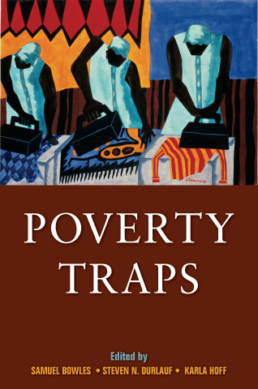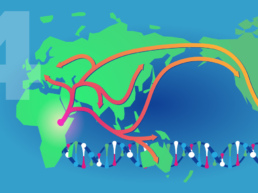Reviewed by M. Krul.
“Poverty Traps” is a collection of research papers on the subject of, well, poverty traps, edited by Bowles, Durlauf and Hoff. Each of these are known for their use of orthodox methodology against the economic orthodoxy itself in substantial terms, and that is also the approach taken in this book. The book consists of a small number of fairly large essays, more or less thematically organized, which seek to explain how poverty traps come into being and how they are reproduced. In this context, a poverty trap is defined as a less-than-optimal solution which is nonetheless an equilibrium, where there also exists an optimal (or at least better) equilibrium.
By far the best part of the book is Part II, which discusses institutions and how they serve to create and reinforce such poverty traps. Engerman & Sokoloff have a fascinating article on the importance of land policies and the crops produced in different parts of the American continent since colonization as a cause of the strong discrepancies in wealth between the North and the Middle/South. Mehlum, Moene and Torvik use classic orthodox methods to show that in African nations, there can be a poverty trap as a result of organized crime, militias etc. being parasites on productive companies, where they keep each other balanced at a suboptimal level. Hoff & Sen have an excellent essay on the problems with kin systems in Africa and Asia and the way in which they can inhibit modernization. And finally Samuel Bowles himself uses a game theoretical mathematical approach to show how suboptimal social conventions can be very hard to change in circumstances of great inequality, despite the amount of people benefiting from the conventions are very few in proportion to those negatively affected. Also of great interest is the first essay in Part III, by Steven Durlauf, which deals with how group pressure and neighborhood influences can account for the continuing bad situation in very black areas of the United States.
What is frustrating about this book is that the authors are so clearly constrained by the faux ‘rigor’ of orthodox economics in fully developing their case. Reading between the lines this seems to have been the case for some of the authors themselves as well, but it will certainly strike any reader that about half the book is devoted to mathematically describing and modelling arguments which are perfectly sensible and easily understood in just their regular written form. The added value of making a model with a host of unworldly and absurd assumptions to prove a particular point that could just as easily be proven in terms of “people tend to behave like X under Y circumstances, because of social cause Z” is unclear, and it is one of the many unfortunate products of the academic atmosphere in the field of economics. What passes for ‘rigor’ is in reality a useless and failed attempt to imitate physics and to impress the noninitiated. It is a pity that this draws smart minds, as the cases of Moene (associated with ‘Analytical Marxism’) and Bowles (the leader in behavioral economics) show – both are approaches which want to do good social science, uninhibited by liberal dogma, but which are hampered by their own insistence on methodological orthodoxy. This is a good scientific work, but its own methodology hinders it.[/vc_column_text][/vc_column][/vc_row]




